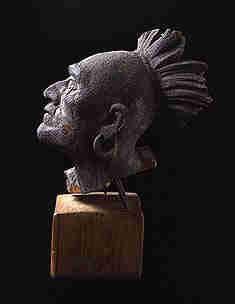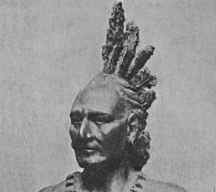Tisquantum or Better Known As "Squanto"

Tisquantum or Better Known As "Squanto" |

|
  Check out these sites to learn more; |
Tisquantum or Better Known As "Squanto"We all grew up learning about how Squanto saved the Pilgrims during their first seasons at Plymouth Colony by teaching them the agricultural techniques of the New World and the celebration of the first Thanksgiving. But there is more to the story, in fact, an epic life that sees the aiding of the Pilgrims at the end of the story. This is the beginning of the story. Tisquantum was a native of the Patuxet tribe, which lived at present day Plymouth, and which belonged to the Wampanoag confederation of tribes. At a young age in the year 1605, Tisquantum was captured by Captain George Weymouth and brought to England, to show his investors some Indians. Tisquantum lived with Sir Ferdinando Gorges, whose Plymouth Company had a lot of financial possibilities to exploit in the New World. Gorges kept Squanto, taught him some English, and eventually hired him to be a guide and interpreter for his sea captains who were exploring the New England coasts. In 1614, he was brought back to America, assisting some of Gorges men in the mapping of the New England coast. After he was done mapping the Cape Cod region, John Smith left in charge a fellow captain by the name of Thomas Hunt, to trade with the Indians a little more. Once Smith had sailed off, Hunt promptly tricked twenty Nausets and seven Patuxets into coming on board his ship to trade and then kidnapped them. Tisquantum, probably on board to act as an interpreter for the trades, was one of those captured. They were bound and sailed to Malaga, Spain, where Hunt tried to sell them for slaves at 20 apiece. Some local Friars discovered what was happening and took the remaining Indians from Hunt in order to instruct them in the Christian faith. Tisquantum lived with the Friars until 1618 when he boarded a ship of Bristol headed for Newfoundland. When Tisquantum arrived in Newfoundland, he was recognized by Captain Thomas Dermer who happened to be there, and who had worked in the past for Sir Ferdinando Gorges. Thomas Dermer wrote a letter to Sir Ferdinando Gorges, stating he had found "his Indian" in Newfoundland and asked what he should do with him. Dermer brought Tisquantum back to Gorges. Gorges organized a trip to send both Dermer and Tisquantum to explore the natural resources and to re-initiate trade with the Indians along the New England coast who had been angry with the English after Hunt had kidnapped members of their tribes. At the end of the expedition, Tisquantum would be returned to his home at Patuxet. Dermer and Tisquantum thus became very close friends. They worked together mapping the resources of the New England coast. When they arrived at Patuxet in 1619, Dermer and Tisquantum soon found out that the entire Patuxet tribe had been wiped out in a plague in 1617. Squanto was the only Patuxet left alive, so he moved in with a neighboring tribe that lived at Pokanoket, the home of Wampanoag sachem Massasoit. Dermer continued on, and while at Cape Cod, he and his crew were attacked by Nausets, and Dermer was taken hostage. Squanto heard about the incident, and came to his friend's aid, and negotiated his safe release. Just little more than a year after Tisquantum was returned to his homeland, the Pilgrims arrived in November 1620. After the Pilgrim explorers checked out all of the surrounding regions, they finally decided to settle at Plymouth in late December.Two months after settling at Plymouth, an Indian from Maine by the name of Samoset walked right into the middle of the Colony which was being built, and welcomed the Pilgrims in English. Somewhat fearful and somewhat astounded, the Pilgrims and Samoset talked all day and night. After Samoset had led several tradings with the Pilgrims, he told the Wampanoag living at Pokanoket that the Pilgrims wanted to make a peace with them. Tribal Leader Massasoit sent Tisquantum to be the interpreter, and on March 22, 1621, the Pilgrims met Tisquantum for the first time. That day, Tisquantum negotiated a peace treaty between Tribal Leader Massasoit and the Wampanoag, and Governor John Carver and the Pilgrims. It essentially stated that the Wampanoag and the Pilgrims would not harm each other, and they became a military alliance as well, such that if one were attacked, the other would come to the aid. Tisquantum lived out the rest of his life in the Plymouth Colony. He befriended the Pilgrims, and taught them how to manure their corn, where to catch fish and eels, and acted as their interpreter and guide. Without Tisquantum's help, the Pilgrims would probably have had severe famine over the next year, and would have lived in constant fear of their Indian neighbors, Indians who were actually quite peaceful, but who had been rightfully angered by the cruel treatment they received from many English ship captains like Thomas Hunt. But in November 1622, while on a trading expedition to the Massachusetts Indians, Tisquantum came down with Indian fever, his nose began to bleed, and he died. Governor William Bradford, perhaps Tisquantum's closest friend and associate among the Pilgrims, wrote the following about his sudden death: "In this place Squanto fell sick of an Indian fever, bleeding much at the nose (which the Indians take for a symptom of death) and within a few days died there; desiring the Governor to pray for him that he might go to the Englishman's God in Heaven; and bequeathed sundry of his things to sundry of his English friends as remembrances of his love; of whom they had great loss." |
Home Idea Gallery Project Gallery Products FAQs Partners Feedback Offers Contact